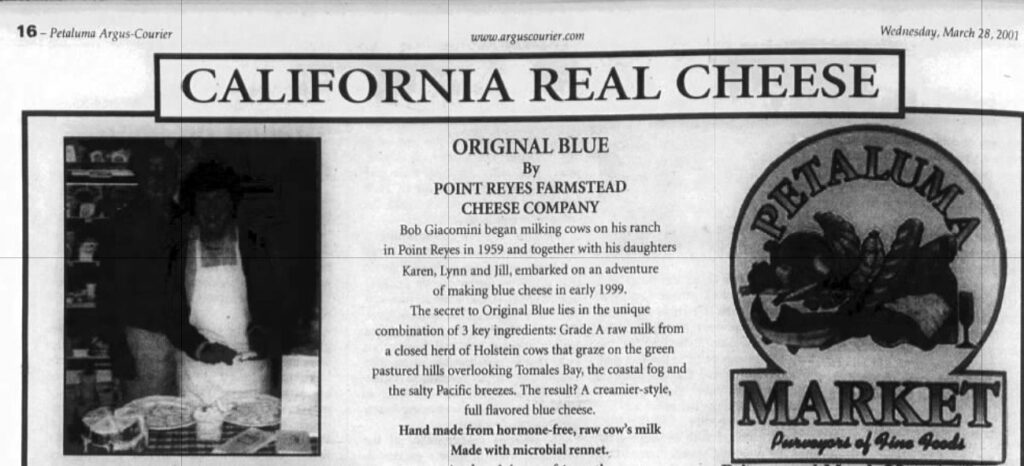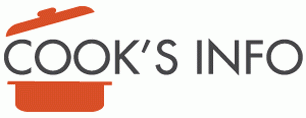Point Reyes Original Blue is a farmhouse blue cheese.
It is very creamy and not crumbly, with no rind. The cheese body is white, with sparse bluish-grey mould veining it. The taste has a bit of a tang because the starter cultures give it a tang like buttermilk, but otherwise the taste is very mild. Consequently some say this is a good introduction to blue cheese for those who are unsure of it.
Website: https://pointreyescheese.com/
Facebook: https://www.facebook.com/pointreyescheese/
Product sheet: Point Reyes Original Blue
Production
The cheese is made by the Point Reyes Dairy in Point Reyes, Tomales Bay, California. They use only their own milk from their own herd of Holstein cows. [1]”Original Blue, our raw milk cheese, continues to be made on the farm in Point Reyes, exclusively from the milk of our own Holsteins.” —Cheese making. Accessed April 2022 at https://pointreyescheese.com/pages/cheese-making The cows eat grass from the farm year round (they graze when they can be at pasture; in winter, they are fed silage composed of grasses from the farm.) The cows are milked starting at 2 am, and the milk is piped directly into the cheese-making plant at 5:30 am, so that it’s used within hours of being produced.
The dairy homogenizes the milk, but doesn’t pasteurize it. They then add Penicillium roqueforti, salt, vegetarian rennet and a starter culture. The milk is allowed to curdle, then the whey is drained off. The curds are formed into 6 ½ pound (3 kg) wheels, which are rubbed with salt for the next 3 days.
Holes are poked into the wheels, then the wheels are allowed to sit in a cool place for 3 weeks. The cheese is then wrapped in foil to prevent a rind forming, and aged 3 1/ 2 months. [2]”Aged 3.5 months.” Original Blue. Accessed April 2022 at https://pointreyescheese.com/products/original-blue
See also: Raw milk
History Notes
Bob Giacomini had the Point Reyes dairy since 1959. In the 1990s, he wanted to pursue higher-value outlets for his cow’s milk. And at the same time, his four daughters encouraged him to make a cheese, as they didn’t want take over a farm that did just milk.
To create and make a cheese, they engaged cheesemaker Monte McIntyre, who had formerly been the manager of the Maytag Blue Cheese dairy in Iowa. [3]Green, Emily. Point Reyes invents a New Kind of Blue. Los Angeles, California: The Los Angeles Times. Sunday, 18 November 2001. Page H6, col. 2.
Port Reyes Original Blue went into production in August 2000. [4]”They began production in August 2000.” — Green, Emily. Point Reyes invents a New Kind of Blue. Los Angeles, California: The Los Angeles Times. Sunday, 18 November 2001. Page H6, col. 2. [5]It was called “Original” already by at least 2001. California farmstead cheesemaking on rise. San Francisco, California: The San Francisco Examiner. 7 March 2001. Page C2, col. 4.
A 2001 piece in the Los Angeles Times traces the business origins of the cheese business, as well as the origins of the actual “recipe” for the cheese:
“Since buying his Tomales Bay ranch in 1959, Bob Giacomini was largely content to work in this market and send the milk he produced off to the local co-op for pasteurization and homogenization. But as he entered his 60s in 1998, he had accumulated a massive herd of 500 Holsteins. This is roughly 10 times the scale of the average Wisconsin farm and, while increasingly typical in California, it is not ideal for the farmer, the livestock or the environment. He wanted a change. “I wanted to downsize the herd….”
One way to do this, but retain income, he realized, was to turn to cheese-making. Milk commands a better price in the form of cheese. If he made enough of a type capable of commanding a decent premium, he reckoned that he could reduce the size of the herd…
But the “real main” reason that Bob Giacomini says he decided to go into cheese-making was his daughters. “The girls didn’t want to be in the dairy business,” he says, “but when we mentioned a cheese plant, they jumped up. It’s brought the family back on the farm.”
Three of his four daughters — Lynn, Jill and Karen (the fourth daughter, Diana, works in banking in San Francisco) — then set about deciding what type of cheese they should make. Hard? Soft? Edam? Camembert? “We had no background, no experience in cheese-making.” says daughter Karen. “We all have business degrees.”
So they canvassed chefs, shopkeepers and dairy industry wonks. “Time and again the word ‘blue’ came up,” she says. “We also learned there was no premium California blue, especially a farmstead. We thought, ‘Hey, there’s a hole out there, let’s fill it.'”
After more than a year of research, in June 1999, the father and daughters began converting an old barn into a state-of-the-art cheese plant with two 1,500-gallon vats capable of producing more than a quarter-million pounds of cheese a year. The family refuses to say how much they’ve spent on the project. They knew what to do, says Karen, “from visiting other plants around the country.” But by the spring of 2000, they still didn’t have a cheese-maker and the most they had done to learn cheese-making was to take a several-day mini-course in Minnesota.
Then they met Monte McIntyre. If Point Reyes Original Blue began anywhere, it began in South Dakota, where Monte McIntyre was raised on a dairy farm. “I grew up in a family, what I would term a Velveeta-type family,” he says. “We really didn’t have a taste for fine cheese. But even as a child the few times we would have a meal in town, on my salad, I would always order blue cheese dressing.”…
McIntyre’s move to the Giacominis in July 2000 was the result of matchmaking by the California Milk Advisory Board, which put the two parties together….
[He] will explain some basic techniques, and why his blue cheese is so different so much wetter than Stilton, sweeter than Gorgonzola, so much less pungent than Roquefort, and most like a mild, rich Danish-style blue. The cream is homogenized, he does divulge, pointing out the piping leading to the machine that busts up the fat globules so when the milk finally forms a curd, it will have plenty of little holes. “In blue cheese I want that quality,” he says. “I don’t see it as a defect.”
While he homogenizes the cream, something that most cheese-makers don’t, he refuses to pasteurize the milk, something most cheesemakers do. “We believe there are flavors and taste in raw milk that you lose if you pasteurize,” he says. In the case of his cheese, he says, aging of the cheese takes care of the pathogens.
The blue in blue cheese comes from the addition of special molds. McIntyre won’t say which brand of blue he uses, or how much he adds when the milk is being curdled in the enormous vats. But he will admit that he likes his blue cheese veining to be on the greenish side. The mold develops in the characteristic veins during aging. To promote this, after the curd is poured into hoops and formed into rounds, it is punched with needles to allow air in for the mold to grow.
It is also repeatedly salted. This is done for three reasons. “Number one is flavor. Number two is to expel moisture. It dries out the curd. The third is really antibacterial. It retards growth of undesired bacteria or yeasts and even other molds.”
Finally, Point Reyes Original Blue is aged in plastic bags. These have enough perforation to allow some evaporation, but far less than an old-fashioned cloth rind. So as the cheese ages, it keeps a soft, wet texture, whiter color and far more water weight than, say, a cloth-bound Stilton.” — Green, Emily. Point Reyes invents a New Kind of Blue. Los Angeles, California: The Los Angeles Times. Sunday, 18 November 2001. Page H6, col. 2.

Point Reyes Original Blue Cheese Promotion in: Petaluma, California: Petaluma Argus-Courier. Wednesday, 28 March 2001. Page 16.
References
| ↑1 | ”Original Blue, our raw milk cheese, continues to be made on the farm in Point Reyes, exclusively from the milk of our own Holsteins.” —Cheese making. Accessed April 2022 at https://pointreyescheese.com/pages/cheese-making |
|---|---|
| ↑2 | ”Aged 3.5 months.” Original Blue. Accessed April 2022 at https://pointreyescheese.com/products/original-blue |
| ↑3 | Green, Emily. Point Reyes invents a New Kind of Blue. Los Angeles, California: The Los Angeles Times. Sunday, 18 November 2001. Page H6, col. 2. |
| ↑4 | ”They began production in August 2000.” — Green, Emily. Point Reyes invents a New Kind of Blue. Los Angeles, California: The Los Angeles Times. Sunday, 18 November 2001. Page H6, col. 2. |
| ↑5 | It was called “Original” already by at least 2001. California farmstead cheesemaking on rise. San Francisco, California: The San Francisco Examiner. 7 March 2001. Page C2, col. 4. |

